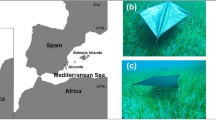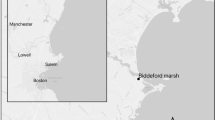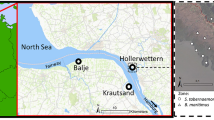Abstract
Plant species can be characterized by different growth strategies related to their inherent growth and recovery rates, which shape their responses to stress and disturbance. Ecosystem engineering, however, offers an alternative way to cope with stress: modifying the environment may reduce stress levels. Using an experimental study on two seagrass species with contrasting traits, the slow-growing Zostera marina vs. the fast-growing Zostera japonica, we explored how growth strategies versus ecosystem engineering may affect their resistance to stress (i.e. addition of organic material) and recovery from disturbance (i.e. removal of above-ground biomass). Ecosystem engineering was assessed by measuring sulphide levels in the sediment porewater, as seagrass plants can keep sulphide levels low by aerating the rhizosphere. Consistent with predictions, we observed that the fast-growing species had a high capacity to recover from disturbance. It was also more resistant to stress and still able to maintain high standing stock with increasing stress levels because of its ecosystem engineering capacity. The slow-growing species was not able to maintain its standing stock under stress, which we ascribe to a weak capacity for ecosystem engineering regarding this particular stress. Overall, our study suggests that the combination of low-cost investment in tissues with ecosystem engineering to alleviate stress creates a new path in the growth trade-off between investment in strong tissues or fast growth. It does so by being both fast in recovery and more resistant. As such low-cost ecosystem engineering may occur in more species, we argue that it should be considered in assessing plant resilience.





Similar content being viewed by others
References
Armstrong W (1971) Oxygen diffusion from the roots of rice grown under waterlogged conditions. Physiol Plant 24:242–247. https://doi.org/10.1111/j.1399-3054.1971.tb03487.x
Armstrong J, Armstrong W, Beckett PM (1992) Phragmites australis: Venturi- and humidity-induced pressure flows enhance rhizome aeration and rhizosphere oxidation. New Phytol 120:197–207. https://doi.org/10.1111/j.1469-8137.1992.tb05655.x
Bertness MD, Callaway R (1994) Positive interactions in communities. Trends Ecol Evol 9:191–193
Boese BL, Alayan KE, Gooch EF, Robbins BD (2003) Desiccation index: a measure of damage caused by adverse aerial exposure on intertidal eelgrass (Zostera marina) in an Oregon (USA) estuary. Aquat Bot 76:329–337. https://doi.org/10.1016/S0304-3770(03)00068-8
Bos AR, Bouma TJ, de Kort GLJ, van Katwijk MM (2007) Ecosystem engineering by annual intertidal seagrass beds: sediment accretion and modification. Estuar Coast Shelf Sci 74:344–348. https://doi.org/10.1016/j.ecss.2007.04.006
Bouma TJ, de Vries MB, Low E et al (2005) Trade-offs related to ecosystem engineering: a case study on stiffness of emerging macrophytes. Ecology 86:2187–2199
Bouma TJ, Olenin S, Reise K, Ysebaert T (2009) Ecosystem engineering and biodiversity in coastal sediments: posing hypotheses. Helgol Mar Res 63:95–106. https://doi.org/10.1007/s10152-009-0146-y
Bouma TJ, de Vries MB, Herman PMJ (2010) Comparing ecosystem engineering efficiency of two plant species with contrasting growth strategies. Ecology 91:2696–2704
Bruno JF, Stachowicz JJ, Bertness MD (2003) Inclusion of facilitation into ecological theory. Trends Ecol Evol 18:119–125. https://doi.org/10.1016/S0169-5347(02)00045-9
Crain CM, Bertness MD (2006) Ecosystem engineering across environmental gradients: implications for conservation and management. Bioscience 56:211–218
Dawkins R (1982) The extended phenotype: the long reach of the gene. Oxford University Press Inc., Oxford, UK
Duarte CM (1991) Seagrass depth limits. Aquat Bot 40:363–377. https://doi.org/10.1016/0304-3770(91)90081-F
Facelli JM, Pickett S (1991) Plant litter : Its dynamics and effects on plant community structure. Bot Rev 57:1–32
Fonseca MS, Fisher JS (1986) A comparison of canopy friction and sediment movement between four species of seagrass with reference to their ecology and restoration. Mar Ecol Prog Ser 29:15–22
Frederiksen MS, Holmer M, Borum J, Kennedy H (2006) Temporal and spatial variation of sulfide invasion in eelgrass (Zostera marina) as reflected by its sulfur isotopic composition. Limnol Oceanogr 51:2308–2318
Ganthy F, Sottolichio A, Verney R (2013) Seasonal modification of tidal flat sediment dynamics by seagrass meadows of Zostera noltii (Bassin d’Arcachon, France). J Mar Syst 109–110:233–240. https://doi.org/10.1016/j.jmarsys.2011.11.027
Ganthy F, Soissons LM, Sauriau P-G et al (2015) Effects of short flexible seagrass Zostera noltei on flow, erosion and deposition processes determined using flume experiments. Sedimentology 62:997–1023. https://doi.org/10.1111/sed.12170
Govers LL, de Brouwer JHF, Suykerbuyk W et al (2014) Toxic effects of increased sediment nutrient and organic matter loading on the seagrass Zostera noltii. Aquat Toxicol 155:253–260. https://doi.org/10.1016/j.aquatox.2014.07.005
Greve TM, Borum J, Pedersen O (2003) Meristematic oxygen variability in eelgrass (Zostera marina). Limnol Ocean 48:210–216
Grime JP (1974) Vegetation classification by reference to strategies. Nature 250:26–31. https://doi.org/10.1038/250026a0
Grime JP (1977) Evidence for the existence og three primary strategies in plants and its relevance to ecological and evolutionary theory. Am Nat 111:1169–1194
Hall Cushman J, Waller JC, Hoak DR (2010) Shrubs as ecosystem engineers in a coastal dune: influences on plant populations, communities and ecosystems. J Veg Sci 21:821–831. https://doi.org/10.1111/j.1654-1103.2010.01196.x
Han Q, Soissons LM, Liu D et al (2017) Individual and population indicators of Zostera japonica respond quickly to experimental addition of sediment-nutrient and organic matter. Mar Pollut Bull 114:201–209. https://doi.org/10.1016/j.marpolbul.2016.08.084
Hasler-Sheetal H, Holmer M (2015) Sulfide intrusion and detoxification in the seagrass Zostera marina. PLoS One 10:e0129136. https://doi.org/10.1371/journal.pone.0129136
Hemminga MA, Duarte CM (2000) Seagrass ecology. Cambridge University Press, Cambridge
Hille Ris Lambers R, Rietkerk M, van Den Bosch F et al (2001) Vegetation pattern formation in semi-arid grazing systems. Ecology 82:50–61
Jabot F, Pottier J (2012) A general modelling framework for resource-ratio and CSR theories of plant community dynamics. J Ecol 100:1296–1302. https://doi.org/10.1111/j.1365-2745.2012.02024.x
Jones CG, Lawton JH, Shachak M (1994) Organisms as ecosystem engineers. Oikos 69:373–386
Jones CG, Lawton JH, Shachak M (1997) Positive and negative effects of organisms as physical ecosystem engineers. Ecology 78:1946–1957. https://doi.org/10.1890/0012-9658(1997)078%5b1946:PANEOO%5d2.0.CO;2
Jovanovic Z, Pedersen MØ, Larsen M et al (2015) Rhizosphere O2 dynamics in young Zostera marina and Ruppia maritima. Mar Ecol Progress Ser 518:95–105. https://doi.org/10.3354/meps11041
Kilminster K, Walker D, Thompson P, Raven J (2008) Changes in growth, internode distance and nutrient concentrations of the seagrass Halophila ovalis with exposure to sediment sulphide. Mar Ecol Prog Ser 361:83–91. https://doi.org/10.3354/meps07479
Klap VA, Hemminga MA, Boon JJ (2000) Retention of lignin in seagrasses: angiosperms that returned to the sea. Mar Ecol Prog Ser 194:1–11. https://doi.org/10.3354/meps194001
Lamers LPM, Govers LL, Janssen ICJM et al (2013) Sulfide as a soil phytotoxin-a review. Front Plant Sci 4:268. https://doi.org/10.3389/fpls.2013.00268
MacArthur RH, Wilson EO (1967) The theory of island biogeography. Princeton University Press, Princeton
Marbà N, Duarte CM (1998) Rhizome elongation and seagrass clonal growth. Mar Ecol Prog Ser 174:269–280
Marbà N, Duarte CM, Terrados J et al (2009) Effects of seagrass rhizospheres on sediment redox conditions in SE Asian coastal ecosystems. Estuaries Coasts 33:107–117. https://doi.org/10.1007/s12237-009-9250-0
Matthews B, de Meester L, Jones CG et al (2014) Under niche construction: an operational bridge between ecology, evolution and ecosystem science. Ecol Monogr 84:245–263. https://doi.org/10.1002/ecy.2446
McGlathery KJ, Reynolds LK, Cole LW et al (2012) Recovery trajectories during state change from bare sediment to eelgrass dominance. Mar Ecol Prog Ser 448:209–221. https://doi.org/10.3354/meps09574
Mumby PJ, Anthony KRN (2015) Resilience metrics to inform ecosystem management under global change with application to coral reefs. Methods Ecol Evol. https://doi.org/10.1111/2041-210X.12380
Pedersen MØ, Kristensen E (2015) Sensitivity of Ruppia maritima and Zostera marina to sulfide exposure around roots. J Exp Mar Bio Ecol 468:138–145. https://doi.org/10.1016/j.jembe.2015.04.004
Peralta G, van Duren LA, Morris EP, Bouma TJ (2008) Consequences of shoot density and stiffness for ecosystem engineering by benthic macrophytes in flow dominated areas: a hydrodynamic flume study. Mar Ecol Prog Ser 368:103–115. https://doi.org/10.3354/meps07574
Pianka ER (1970) On r- and K-selection. Am Nat 104:592–597
Puijalon S, Bouma TJ, Douady CJ et al (2011) Plant resistance to mechanical stress: evidence of an avoidance—tolerance trade-off. New Phytol 191:1141–1149
Soana E, Bartoli M (2014) Seasonal regulation of nitrification in a rooted macrophyte (Vallisneria spiralis L.) meadow under eutrophic conditions. Aquat Ecol 48:11–21. https://doi.org/10.1007/s10452-013-9462-z
Soissons LM, Han Q, Li B et al (2014) Cover versus recovery: contrasting responses of two indicators in seagrass beds. Mar Pollut Bull 87:211–219. https://doi.org/10.1016/j.marpolbul.2014.07.057
Tilman D (1990) Constraints and tradeoffs: toward a predictive theory of competition and succession. Oikos 58:3–15
Touchette BW, Smith GA, Rhodes KL, Poole M (2009) Tolerance and avoidance: two contrasting physiological responses to salt stress in mature marsh halophytes Juncus roemerianus Scheele and Spartina alterniflora Loisel. J Exp Mar Biol Ecol 380:106–112. https://doi.org/10.1016/j.jembe.2009.08.015
van Katwijk MM, Hermus DCR (2000) Effects of water dynamics on Zostera marina: transplantation experiments in the intertidal Dutch Wadden Sea. Mar Ecol Prog Ser 208:107–118. https://doi.org/10.3354/meps208107
van Wesenbeeck BK, Crain CM, Altieri AH, Bertness MD (2007) Distinct habitat types arise along a continuous hydrodynamic stress gradient due to interplay of competition and facilitation. Mar Ecol Prog Ser 349:63–71. https://doi.org/10.3354/meps07051
Westoby M (1998) A leaf-height-seed (LHS) plant ecology strategy scheme. Plant Soil 199:213–227
Widdows J, Pope ND, Brinsley MD et al (2008) Effects of seagrass beds (Zostera noltii and Z. marina) on near-bed hydrodynamics and sediment resuspension. Mar Ecol Prog Ser 358:125–136. https://doi.org/10.3354/meps07338
Wissel C (1984) A universal law of the characteristic return time near thresholds. Oecologia 65:101–107
Acknowledgements
This study was conducted as part of the NSFC-NWO “Water ways, Harbours, Estuaries and Coastal Engineering” scheme, and it was co-supported by the National Natural Science Foundation of China (no. NSFC41061130543) and the Netherlands Organisation for Scientific Research (no. 843.10.003). We thank the local managers from Moon Lake for their interest and support in implementing the experiments. We are also grateful to the students from the Yantai Institute for Coastal zone research-Chinese Academy of Sciences (YIC-CAS) for their help and time during field experiments and measurements done in China.
Author information
Authors and Affiliations
Contributions
LMS, MMvK, TY, PMJH and TJB conceived and designed the experiment. LMS, BL and QH executed and analysed the data collected as part of the field manipulative experiment. LMS, MMvK and TJB wrote the manuscript, and other authors provided editorial advice.
Corresponding author
Additional information
Communicated by Hermann Heilmeier.
Rights and permissions
About this article
Cite this article
Soissons, L.M., van Katwijk, M.M., Li, B. et al. Ecosystem engineering creates a new path to resilience in plants with contrasting growth strategies. Oecologia 191, 1015–1024 (2019). https://doi.org/10.1007/s00442-019-04544-4
Received:
Accepted:
Published:
Issue Date:
DOI: https://doi.org/10.1007/s00442-019-04544-4




